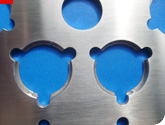DFM Guidelines to Simplify Manufacture
Design for Manufacturing (DFM) integrated into the product design simplifies the manufacturing process. The goal is to design a product that can be easily and economically manufactured. The importance of DFM is highlighted by the fact that around 70% of manufacturing costs of a product (cost of materials, machining, and assembly) are determined by design decisions, with manufacturing decisions (such as process planning or machine tool selection) responsible for only 20%. DFM guidelines help the design team to simplify product manufacture and therefore overall project costs.
Below is a list of DFM guidelines:
1. Reduce the total number of parts
By reducing the number of parts in a product design, this provides the best opportunity for reducing manufacturing costs. Fewer parts mean less engineering development time, purchases, inventory, work-in-processing time, fabrication and assembly steps, inspection, etc. Overall it reduces the level of intensity of all product-related activities. The design teams focus is to evaluate each part to see if it can be eliminated, combined with another part or its function can be performed in a simpler way. Does the part move relative to other moving parts. Does the part have to be made of a different material from the other parts.
2. Standard components plus common parts and materials
Design using "off the shelf" standard components that are less expensive than custom-made items and they simplify the design. Common parts and materials will reduce inventory, costs and product lead times.
3. Design for ease of fabrication
Select processes compatible with the materials and production volumes. Select materials compatible with production processes that reduce processing time but meet functional requirements. Final surface requirements such as painting, polishing, finish machining, should be clearly understood and design intent accurately defined.
Guidelines to be considered during design:
- For higher volume parts, consider castings, extrusions or other volume manufacturing processes to reduce machining
- Use near net shapes for molded and forged parts to minimize machining and processing effort.
- Design for ease of fixturing by providing large solid mounting surface & parallel clamping surfaces
- Avoid designs requiring sharp corners or points in cutting tools - they break easier
- Avoid thin walls, thin webs, deep pockets or deep holes to withstand clamping & machining without distortion
- Avoid tapers & contours as much as possible in favor of rectangular shapes
- Avoid undercuts which require special operations & tools
- Avoid hardened or difficult machined materials unless essential to requirements
- Put machined surfaces on same plane or with same diameter to minimize number of operations
- Design workpieces to use standard cutters, drill bit sizes or other tools
- Avoid small holes (drill bit breakage greater) & length to diameter ratio > 3
- Threaded holes design for full thread depth, usually 1.5 x major diameter
- Drilled hole depth is recommended to be at least equal to the full thread plus 1/2 major diameter
- Material thickness as measured from the bottom of the drilled hole to next surface should not be less than the major diameter of the thread or diameter of hole
- Internal Radii always specify largest radius possible. Small diameter tools add significant cost to manufacturing process
- Simplify design and assembly so that the assembly process is unambiguous
- Parts must be designed to consistently orient themselves. Examples are dowel pins
- Product design must avoid parts that can become tangled, wedged or disoriented
- Verify clearance for assembly tooling such as hand tools and fixtures
- With hidden features that require a particular orientation, provide an external feature, guide surface or design alignment fixturing or tooling to correctly orient the part
- Design in fasteners large enough that are easy to handle and install
- Design for efficient joining and fastening
- Threaded fasteners (screws, bolts, nuts and washers) can be time-consuming to assemble. Consider design alternatives that will reduce fastener count. Use uniform screw sizes where practical
Design of tolerances to be within manufacturing capabilities
Continually designing for manufacturing will improve product quality and reduce fabrication costs. After completion of preliminary drawings, meet with manufacturing and review design intent, requirements and determine manufacturing process requirements. Manufacturing to review tolerances and determine process capabilities to meet dimensional limits. In general, the design to avoid unnecessarily tight tolerances that are beyond the natural capability of the manufacturing processes. Determine when new production process capabilities are needed early to allow sufficient time to determine optimal process parameters and establish a controlled process. Tolerance stack-ups should be considered on mating parts. Overall assembly tolerances should be calculated, and interface as well as clearance requirements understood.
CAD Software 3D Modeling to evaluate product design
With today’s advances in PC & software power, using CAD software for example Autodesk Inventor is a very powerful tool to evaluate your product design. This is a good time to pull the design team and manufacturer together to demonstrate and evaluate the product parts, subassemblies & assemblies. This will allow the review of the majority of the above DFM guidelines and most importantly how the physical-relationship of the parts work together when viewed as a 3D model.

